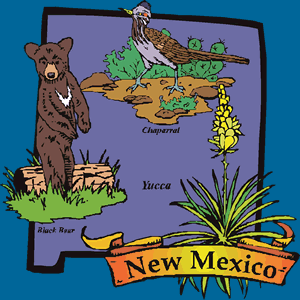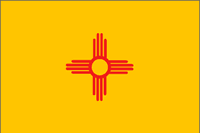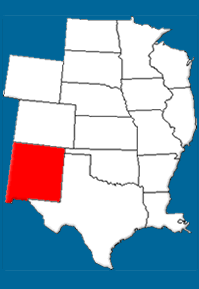 History:
The first European to reach what is now the state of New Mexico was Cabeza de Vaca. De Vaca was part of an expedition in search of gold in Florida. When their ship wrecked just off the Texas coast, they came ashore and wandered across southern New Mexico between 1528 and 1536. The expedition encountered the pueblo villages of the Native Americans and brought word back to the Spanish of their experiences.
The Spaniards believed these pueblos to be the legendary Seven Cities of Cibola. In 1539, Carcos de Niza made a search of the area, guided by a member of de Vaca's earlier expedition. De Niza claimed the area as a province of Spain and identified the pueblos as the fabulously wealthy Seven
Cities.
A full-scale expedition, led by Francisco Vasquez de Coronado, explored the region from 1540-1542, and found only the pueblos. Because of Coronado's treatment of the Pueblo people, hostility developed between the Spanish and the Native Americans. As a result, colonization of the region was slowed.
The first Spanish colony in New Mexico was founded in 1598 by Juan de Onate at San Juan, near the Chama River. Onate became governor of the province. His successor, Pedro de Peralta, established the capital of the province at Santa Fe in 1610. The colony grew very slowly. Missions were established and Roman Catholic priests set up schools. But the Spanish forced the Native Americans into slave labor and attempted to convert them to Christianity. These factors led to an Apache uprising in 1676 and a Pueblo revolt in 1680. The Spanish soon left New Mexico.
Spanish control of the province was reestablished by Governor Diego de Vargas Zapata in 1692. Gradually, colonists began to reenter the province. Missionaries came back to establish missions in and near Santa Fe.
In 1821, Mexico achieved its independence from Spain, and New Mexico became a province of Mexico. The Santa Fe Trail was opened that same year, allowing goods to be transported to the province from Missouri.
Trouble gradually developed between Mexico and the United States as American colonists moved further into the southwest. The Mexican War began in 1846 when General Stephen Kearney entered Santa Fe and took control of New Mexico. Two years later, the Treaty of Guadalupe Hidalgo ended the conflict. The region of New Mexico was ceded to the United States.
New Mexico was officially organized as a territory of the United States in 1850, and James Calhoun served as its first governor. In 1853, the Gadsden Purchase added the land that is now Arizona and parts of present-day Colorado, Nevada, and Utah to the territory.
Because slavery was unrestricted in the territory, New Mexico was initially occupied by Confederate troops during the Civil War. In 1862, Union troops recaptured the territory after two military clashes. The first was in Apache Canyon, and the second in Glorieta Pass.
After the war ended, conflicts with the Apache and Navajo continued. Frontier scout Kit Carson led residents of the territory in forcing Apache and Navajo Indians to live on reservations. Much of the unrest ended with the surrender of Apache chief Geronimo in 1886.
During the 1870s, The Lincoln County War marked a bitter time of conflict for political control within the territory. Cattle ranchers felt overwhelmed by the squatters and homesteaders who took over the grazing land. Billy the Kid and other outlaws took part in the fighting which ended in 1878 when territorial governor General Lew Wallace brought in troops to end the bloodshed.
New Mexico experienced much growth in the late 1880s as a result of the railroads, which linked the territory to the rest of the country. Ranching and mining thrived, attracting many settlers. In 1912, New Mexico became the nation's 47th state. |









